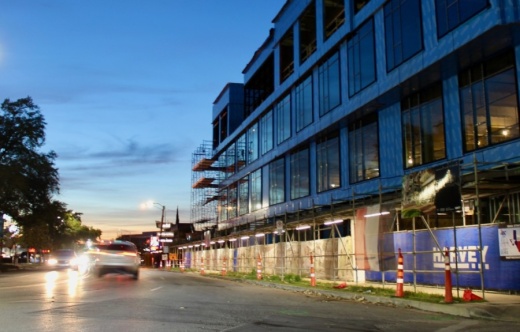“I was telling this Uber driver once ... ‘Man, it’s so bad I have to keep changing my tires,’ and I guess I kept going on and on, and he said to me, ‘Man, you’ve really been upset a long time,’” he said. “He was right. And I had to do something about it.”
Vergel took his experience in activism during the HIV/AIDS epidemic and some social media savvy and started organizing his neighbors to begin speaking up. Soon he connected with other groups advocating for the neighborhood, eventually forming the Montrose Residents Coalition, a group of more than 600 residents that serves as a sounding board for concerns.
“Lower Westheimer—that really triggered everything,” he said, referring to the delayed improvements of the roadway near Midtown. “And now we see these developments; it’s a compounding effect. I see the anger building, the worry.”
In the coming weeks, international development firm Skanska plans to clear its property at Montrose Boulevard and Westheimer—one of several significant projects underway—as local officials and advocates try to keep up.
“We’re not trying to dictate the project, but we do want to make sure it honors the neighborhood and doesn’t destroy the sewers,” said Amanda Wolfe, a 14-year resident and former City Council candidate. “This thing could be huge.”
Changing up
The Montrose Addition, platted in 1911, was Houston’s first large-scale planned suburb. It boasted tree-lined boulevards, paved sidewalks and its own streetcar shuttling commuters every seven minutes downtown. A collection of neighborhoods sprung up around it, all forming the Montrose area. In 1937, when the first set of deed restrictions began to expire, residents began to worry about commercial encroachment.
From about the 1960s onward, it went from a well-to-do enclave to a bohemian, counter-culture inner-city destination and, eventually, a nexus for the city’s LGBTQ community. It attracted artists, restaurateurs, students and misfits.
“The people who make Montrose come from all financial groups and interests. We want them all here,” said Randy Romman, a real estate agent and Montrose resident for about a decade.
The past few years of development, however, represent a shift in tone and demographics.
“Montrose is really special. It is charming and funky, and more and more people started moving here and seemed to be saying, ‘Wow this is so cool—let’s change it,’” Wolfe said.
The area has seen over 250 residential and commercial demolitions since 2018, according to city records. While historic districts and minimum lot sizes protect some aspects of the neighborhood, there are few commercial redevelopment rules.
“We’ve lost a lot already,” Wolfe said. “That sense of discovery, like, ‘Oh wow, I’ve lived here 10 years and never knew that existed’ kind of thing—I worry that’s going away and we’re just going to get another Starbucks or something that’s already everywhere.”
Ask a Montrose resident when the change started and it will vary—some say it was the mid-2010s, when the shuttered gay bar Mary’s became a coffee shop or when the Texas Junk Co. closed its doors, or even this year, when Half Price Books cleared its shelves or when “Disco” Kroger closed.
“The reality is it started 100 years ago, and that’s what Montrose was then,” said Randy Mitchmore, a longtime resident, business owner and former board chair for the Montrose Redevelopment Authority. “It’s always changing. It’s not going to be the same for any of those folks.”
Buying in
Developers are not required to gain community support for projects, but some have taken the step to seek it.
“People in this area care. They care about the architecture and the community. They are discerning. Montrose isn’t the best location to throw up a suburban-style strip center or generic office building,” said Barton Kelly with Radom Capital, the firm overseeing the Montrose Collective project.
Radom Capital held public meetings in fall 2019 as part of an effort to partner with the city and move the Montrose library branch to the new building. It also partnered with the Montrose Redevelopment Authority—the tax increment reinvestment zone established in 2015 to spur economic growth and infrastructure projects—to set aside public parking spaces.
Public feedback informed the final building design, Kelly said.
“We took measures to design around the 100-year-old live oaks on Grant Street, which was mentioned by some citizens,” said Kelly, who sits on the board for the nonprofit Trees for Houston.
Skanska, meanwhile, plans a large mixed-use project with retail, office and residential, but exact details have not been announced. However, officials did say they were looking forward to working with organizations and businesses in the process. It also plans to hold community events at the development site prior to construction.
“Our goal is to deliver a product that benefits and fulfills the needs of the local neighborhood,” Matt Damborsky, executive vice president and regional manager of Skanska USA Commercial Development, wrote in a statement to Community Impact Newspaper.
Given escalating land costs, developers are pushed to make maximum use of their footprint. The Montrose Collective, The Allen high-rise project, Regent Square and Autry Park are all mixed-use developments that are reshaping entire city blocks.
“Montrose is not getting dense; it is dense,” said Romman, who also runs the Instagram account Walking Houston, showcasing new projects inside the Loop. “I love the new approach to dense, walkable, sustainable, transit-oriented development. But you also want to see the same investment in the streets and sidewalks.”
Building out
The MRA has taken strides in the past year to bolster the area’s infrastructure for walking and biking and will soon have a drainage plan up for review along with the culmination of its Livable Centers study, which will serve as a master blueprint for future projects, officials said.
The authority, which is funded by the TIRZ, is projected to spend $108 million on corridor improvements over the next 30 years, but officials said they want to make every attempt to find matching funds.
“The Zone is particularly interested in partnerships across all public sector partners ... to leverage that tax dollar and accomplish more in joint partnerships,” board Chair Joe Webb wrote in a statement to Community Impact Newspaper.
A partnership with Harris County Precinct 1, for example, is implementing the first of almost two dozen projects aimed at sidewalk and street improvements for pedestrians and bicyclists. The Commonwealth Street and Waugh Road project could see construction this spring, and two more projects are in development.
“The objective is to have the design of all pedestrian and bicycle projects completed within a 3-year window,” Webb wrote.
The Metropolitan Transit Authority of Harris County will be another key partner, which is slated to bring its Bus Operations Optimized System Treatments network service to Montrose Boulevard and Westheimer Road as well as bus rapid transit down Richmond Avenue, a venture that will require a complete rebuild.
Neighborhood advocates said Lower Westheimer remains the biggest improvement waiting to happen.
“We’re one pothole away from a bus swerving and ending up on a curb, or a car maybe cutting them off, and the bus rolls onto the sidewalk. It’s scary,” Rommon said. “But any dollar spent there is a high-impact dollar. Everyone who comes to Montrose comes down Lower Westheimer.”
Vergel said he supports the TIRZ but hopes more residents can connect and become advocates. He has reason to believe it might help.
“After a lot of fighting, I finally got my streets repaved,” he said. “They are starting to listen to us.”





